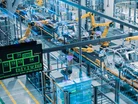5 minutes with Matthew Putman, CEO of Nanotronics

Matthew Putman is the CEO and co-founder of Nanotronics, an industrial AI company he co-founded in 2010 with his father, John Putman. The company is headquartered in New York’s Navy Yard, a rapidly-growing hub of innovation that has witnessed tremendous growth just within the past five years. Nanotronics also has locations in Cuyahoga Falls, Ohio and Hollister, California, as well as Munich.
Nanotronics is a precision manufacturing company that builds AI-powered process control and inspection tools to streamline and improve production across all stages of manufacturing, including automotive/EV, healthcare and electronics.
“We solve some of manufacturing’s most complex problems: how to increase efficiencies, reduce the greenhouse gas footprint and waste and lower costs,” says Matthew. “Through the integration of generative AI solutions, we can clean, sort and manage existing data as well as data collected from factory operations in real-time, to create an essentially autonomous factory. We work with all types of companies to increase profits, develop greener production processes and ultimately increase manufacturing's social good.”
Here he tells us more about autonomous factory control, how generative AI is shaping the automotive manufacturing space and how rapid adoption of Industrial AI across capital-intensive industries can quell global supply chain problems.
Matthew Putman, CEO and co-founder of Nanotronics
Hi Matthew! Tell us about your role as CEO.
“Innovation in the manufacturing industry has been relatively stagnant since the 1950s. There is a tremendous opportunity to inject new technologies into the manufacturing sector to increase yields, improve the speed of R&D production, cut down on environmental waste, reduce costs and accelerate speed to market. My role as CEO is to help achieve these benefits for our manufacturing clients.”
How is generative AI shaping the automotive manufacturing space?
“Generative AI is revolutionising the automotive industry in a number of ways. This powerful tool speeds up design iteration by condensing vehicle production into a seamless process that self-regulates and improves, helping to meet demand as needed, which expedites innovation and time-to-market. They can assist in creating more efficient and innovative components by intuitively adjusting manufacturing parameters, while offering multiple design choices that optimise structural integrity. Generative AI also provides predictive maintenance functions to reduce downtime and enhance the reliability and lifespan of vehicles.”
Why should the auto industry care about AI in manufacturing?
“As the demand for electric and self-driving vehicles increases, decision makers should invest in AI to remain competitive in the long-term. Automotive manufacturing traditionally involves a complex, slow design cycle. To help speed that up in the era of rapidly-changing smartphones, systems that can eliminate the need for laborious manual adjustments, result in safer autonomous systems, optimised manufacturing processes, increased energy efficiency, and improved maintenance practices.”
How can rapid adoption of Industrial AI across capital-intensive industries quell global supply chain problems?
“Adopting industrial AI in factory spaces, particularly within capital-intensive industries that depend on outsourced labour and materials, enables manufacturers to self-curate supply chains. The emergence and integration of these new AI systems promises to eliminate reliance on volatile markets—that’s because AI is adaptable and agile, able to analyse tremendous quantities of data to identify the most efficient possible shipping routes. This capability reduces transportation expenditures and significantly shortens delivery times. AI can also assist in inventory management and demand forecasting, improving the total operational efficiency of plants as well as consumer/manufacturer relations.”
How can cybersecurity solutions protect data, financial information, and trade secrets?
“AI-backed cybersecurity solutions are highly effective at preventing malicious attacks through precise data management. Encryption algorithms operate by converting sensitive information into unreadable formats, ensuring that unauthorised users will be unable to steal this information even if they do gain access to companies’ databases. AI also offers very exact security monitoring—if any atypical activity is observed, these systems respond promptly to attenuate and prevent data theft.”
What is autonomous factory control?
“Autonomous factory control involves deploying deep learning AI agents throughout all production operations; these systems can learn adaptively, meaning they take feedback from sensors placed strategically throughout customers’ facilities that collect data in real-time. This data might be input from manual assembly processes or, if we take the microelectronics industry as an example, information collected from scans of semiconductor wafers, which is then stored for future reference. This new data is correlated with existing data points to create an ideal “map” for production, generating actionable insights for manufacturers. AI-powered process control detects and predicts anomalies or errors that may arise during the production process. It is essentially an overarching data management architecture and can be thought of as the “immune system” of the factory; what makes it autonomous is that it requires little to no intervention from humans to work effectively and identifies potentially cataclysmic gaps in production that might otherwise go undetected.
“This is not to say that these AI systems will replace humans or render humans somehow obsolete. One of the goals of using this technology is to liberate people from repetitive labour so that they can work on projects that are on par with their unique capabilities; our AI is intended to augment human ingenuity, not negate it.”
How can a manufacturer or process engineer know that it is working?
“Manufacturers and process engineers can closely monitor production through an accessible user-interface that provides human-legible feedback from quantified variables. When the AI platform anticipates an error, it immediately notifies operators about this anomalous activity, preventing factory shutdowns and time-consuming repairs.”
- Schneider Electric's Commitment to Sustainable ManufacturingSustainability & ESG
- Lenovo & Saudi Alat Building Green Manufacturing FacilitySustainability & ESG
- Aggreko: UK Energy Manufacturers must Shore Up Supply ChainSustainability & ESG
- Nissan Brings Biodiversity to the Factory through RewildingSustainability & ESG

